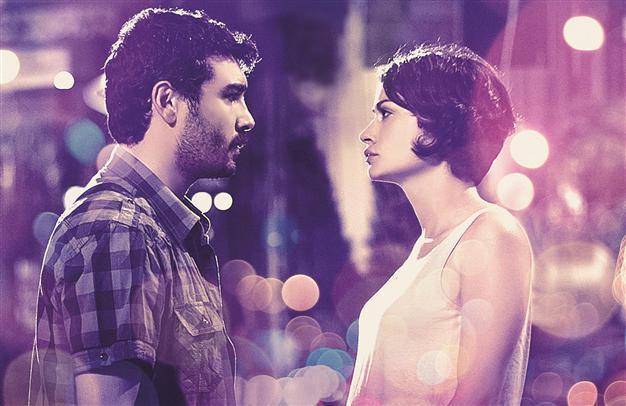Istanbul in movies: Through the eyes of strangers
Emrah Güler ANKARA - Hürriyet Daily News

Director Alpgezmen takes a young woman as her protagonist and takes the ground underneath her feet, taking her on a journey from the streets of Paris to Istanbul. sadibey photo
The English title of this week’s new release “Yabancı” is “The Stranger.” It might as well have been titled “The Foreigner,” the literal translation being the same. Of course, the movie is about estrangement in more ways than one. It’s about being a stranger to one’s own skin, to others around you, to your personal history, and as the most dominant theme here, to your ethnic heritage and geographical roots.In her debut feature, director and writer Filiz Alpgezmen takes a young woman as her protagonist and takes the ground underneath her feet, taking her on a Kafkaesque journey from the streets of Paris to the underbellies of Istanbul and the Turkish bureaucracy. Özgür, played by Sezin Akbaşoğulları, is the daughter of two Turkish refugees who fled to France in the wake of the 1980 coup in Turkey.
Having lost her mother at an early age, Özgür has been raised by her father. The film begins with the death of her father. A letter from him reveals his dying wish to be buried in his homeland. So begins the journey for Özgür to Istanbul, and the subsequent nightmare with the Turkish bureaucracy.
“Your father is not a Turkish citizen,” officials inform her. “Your funeral has no place here. … [There’s] nowhere to be buried.”
Özgür comes to a point where she literally cannot breathe. It’s not just the bureaucracy, but the awkward interactions with the never-before-seen relatives that also put her into a downward spiral.
Then there’s also the city of Istanbul, which mostly shows her its unrelenting face, frequently appearing like a ruthless place for a stranger.
Strangers in Istanbul have taken some screen time in Turkish cinema, perhaps to help the filmmaker depict scenes from a travelogue, or perhaps to solidify their own apprehension of the ruthless face Istanbul can take in the form of someone who shows his/her fear of this formidable city. These strangers are sometimes desperate migrants from rural Turkey, sometimes unsuspecting passersby, and at other times, they are the foreigners who are inserted into the stories to bring a different perspective.
Istanbul as a place of seduction
Perhaps the most famous Turkish movie featuring a foreigner in Istanbul is Turkish-Italian filmmaker Ferzan Özpetek’s internationally acclaimed debut feature “Hamam” (Steam: The Turkish Bath) of 1997.
The foreigner here is Alessandro Gassman’s Francesco, who travels from Naples to Istanbul after his aunt’s death, and decides to extend his stay in Istanbul to restore the shabby hamam left to him by his aunt. His stay in the house of the typical middle-class Turkish family turns into a journey within himself, bringing to mind the powerful line from the movie, “along with bodies, hamams loosen traditions.”
Özpetek’s, and hence Francesco’s, Istanbul is an unpredictable and seductive city – a city that arouses the senses, a city to fall in love with and to fall in love in. The film, however, borders on a travel documentary with scenes of a wedding ceremony, a circumcision ceremony, a belly dancer, fortune-telling through with an empty coffee cup and a generous table featuring Turkish cuisine all presented for the viewer’s consumption. It is, of course, Francesco’s look at Istanbul, and these are what intrigues him the most. Similarly, Özgür in “Yabancı” has to face a relative in a grand circumcision party – something that is not unlike a documentary of an alien culture for her.
Head-On: Another story of a stranger
The Golden Bear-winning classic of 2004, “Gegen die Wand” (Head-On) by the German director of Turkish origin, Fatih Akın, is yet another example of strangers trying to make sense of Istanbul. Similarly to “Yabancı,” the strangers are Turks in Istanbul – two generations of migrants in Germany played by Birol Ünel and Sibel Kekilli. This heartbreaking love story takes place both in Germany and Istanbul, showing the darker side of the city with both characters immersed in pain and self-destruction. An antithesis to “Hamam,” Akın’s Istanbul is suffocating and full of despair.
Traditions, values, and sexual relations are put into perspective through a German character in directors by M. Caner Alper and Mehmet Binay’s award-winner “Zenne” (Zenne Dancer) of 2012. The film is based on the true story of Ahmet Yıldız, a young gay man who was gunned down by his father in July 2008 after coming out to them, and features three characters.
Erkan Avcı’s Ahmet is a gay man from a conservative family from eastern Turkey, while Kerem Can’s Can is a flamboyant belly dancer, an out gay man loved, supported and protected by his family. The German photojournalist Daniel (Giovanni Arvaneh) serves to shed a light on the contradictory nature of Turkey’s look at homosexuality from a distance, playing a character who doesn’t have much of a clue about Turkey’s traditions, values, and dynamics around familial relationships, sexual conduct and masculinity.
Istanbul here becomes the embodiment of these contradictions, but Istanbul actually serves as the embodiment of different contradictions in any and all of these films.
















